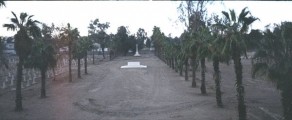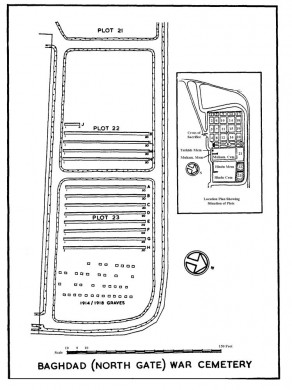Country
Iraq
Locality
unspecified
Identified Casualties
4623
Visiting Information
THE COMMISSION STRONGLY ADVISES THAT THE FOREIGN AND COMMONWEALTH OFFICE SHOULD BE CONTACTED BEFORE ATTEMPTING TO VISIT IRAQ. Their details are as follows: Travel Advice Unit Consular Division Foreign and Commonwealth Office Old Admiralty Building London SW1A 2AF Tel: 0207 008 0232/0233 Fax: 0207 008 0164 Website: http://www.fco.gov.uk/ Opening Times: Monday to Friday 09.30 - 16.00
Local Information
Baghdad (North Gate) War Cemetery is 800 metres beyond the North Gate of the City of Baghdad on the south-eastern side of the road to Baguba.
Historical Information
In 1914, Baghdad was the headquarters of the Turkish Army in Mesopotamia. It was the ultimate objective of the Indian Expeditionary Force 'D' and the goal of the force besieged and captured at Kut in 1916. The city finally fell in March 1917, but the position was not fully consolidated until the end of April. Nevertheless, it had by that time become the Expeditionary Force's advanced base, with two stationary hospitals and three casualty clearing stations. The North Gate Cemetery was begun In April 1917 and has been greatly enlarged since the end of the First World War by graves brought in from other burial grounds in Baghdad and northern Iraq, and from battlefields and cemeteries in Anatolia where Commonwealth prisoners of war were buried by the Turks. At present, 4,160 Commonwealth casualties of the First World War are commemorated by name in the cemetery, many of them on special memorials. Unidentified burials from this period number 2,729. The cemetery also contains the grave of Lieutenant General Sir Stanley Maude, Commander-in-Chief of the Mesopotamian Expeditionary Force, who died at Baghdad in November 1917 and the memorial to the 13th Division which he commanded. A memorial to the 6th Battalion Loyal (North Lancashire) Regiment was brought into the cemetery from the banks of the Diyala River in 1947. During the Second World War, Baghdad was again an objective of Commonwealth forces. The 20th Indian Infantry Brigade reached the city from Shaiba by the Euphrates route on 12 June 1941 and the 21st Indian Infantry Brigade, part of the 13th Duke of Connaught's Own Lancers, together with the 157th Field Regiment, Royal Artillery, arrived on 19 June via the Tigris. An advanced base was established later near the city and remained in use until 1946. Most of the 296 Commonwealth servicemen of the Second World War buried in the cemetery died of illness or by accident when serving with PAIFORCE. Again, a number of the graves were brought in from other burial grounds. Within the cemetery is the Baghdad (North Gate) (Khanaqin) Memorial, commemorating 104 Commonwealth and 440 Polish servicemen of the Second World War buried in Khanaqin War Cemetery which, owing to difficulty of access, could not be properly maintained. A memorial has also been erected at Khanaqin. The North Gate Cemetery also contains 127 war graves of other nationalities from both wars, 100 of them Turkish, and 41 non-war graves.





